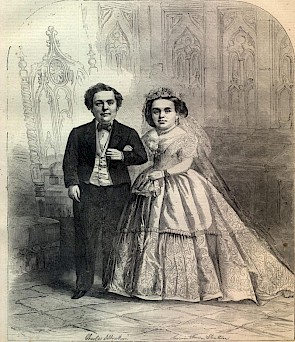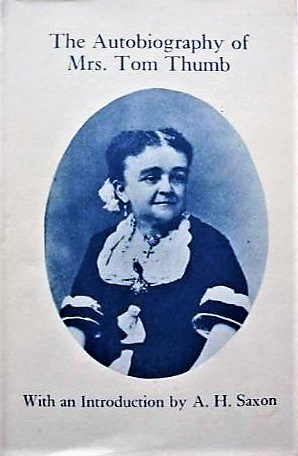
 Bradford Kingman’ was cousin of the very talented vaudeville singer, dancer, storyteller and performer Lavinia Warren Bump. Born in Middleborough, MA in 1841, at age 22 Lavinia married Charles Stratton (AKA Tom Thumb) in an elaborately staged ceremony at Grace Episcopal Church in New York City in 1863. Two thousand invited notable guests were from New York’s high society and theatrical circuts. She was first introduced to the public by P.T. Barnum in 1862 as Lavinia Warren, at that time she was known as the “Little Queen of Beauty” and both she and Stratton were employed by P.T. Barnam. It was Barnam who dropped her last name of “Bump”, and Lavinia was nationally known as ” Warren” until she took her husband’s stage name of “Thumb”. Barnam also staged the couple’s wedding ceremony, and accompanied the newlyweds on a highly publicized world tour shortly thereafter. They immediately became the toast of Europe and guests of royalty (it was Queen Victoria who jokingly bestowed on him the title of “General”; and Barnham used the title for the utmost publicity, and it stuck for the rest of his life).
Bradford Kingman’ was cousin of the very talented vaudeville singer, dancer, storyteller and performer Lavinia Warren Bump. Born in Middleborough, MA in 1841, at age 22 Lavinia married Charles Stratton (AKA Tom Thumb) in an elaborately staged ceremony at Grace Episcopal Church in New York City in 1863. Two thousand invited notable guests were from New York’s high society and theatrical circuts. She was first introduced to the public by P.T. Barnum in 1862 as Lavinia Warren, at that time she was known as the “Little Queen of Beauty” and both she and Stratton were employed by P.T. Barnam. It was Barnam who dropped her last name of “Bump”, and Lavinia was nationally known as ” Warren” until she took her husband’s stage name of “Thumb”. Barnam also staged the couple’s wedding ceremony, and accompanied the newlyweds on a highly publicized world tour shortly thereafter. They immediately became the toast of Europe and guests of royalty (it was Queen Victoria who jokingly bestowed on him the title of “General”; and Barnham used the title for the utmost publicity, and it stuck for the rest of his life).
Throughout their careers, the couple were occasional visitors to town and stayed with Bela Kingman and his family. Bela even got their troupe to perform at the Town Hall for a charity event in August 1879.
The following is a review of the Tom Thumb traveling troupe’s performance in Newmarket in 1879:
“The Tom Thumb entertainment at the Town Hall on Monday evening was a first class affair, and was largely attended. These little midgets always attract a full house. Everybody knows what kind of an entertainment it is, so comment seems to be almost unnecessary. We will add, however, that Major Newell is spryer than ever; his dances and songs and scatorial performances being somewhat remarkable. The farce, “The Mischievous Monkey,” was ably enacted and the talk of the “man of few words” elicited much laughter.”
(photo was the cover of Harper’s Magazine, Feb. 21, 1863 of General Tom Thumb and his wife Lavinia (Warren) )
The Newmarket Advertiser followed the adventures of the couple throughout their careers, and reported their travels and theatrical triumphs regularly. The following was printed in the Advertiser, July 21, 1883 , six days after the death of General TomThumb at his home in Middleborough, MA.
The recent death of General Tom Thumb brings to mind several anecdotes of the renowned dwarf which are probably new to the public at large. As is well known by most of our readers, Mrs. Tom Thumb is a cousin of our popular jeweler, Mr. B. S. Kingman, and when upon their travels in this vicinity the couple always visited Mrs. and Mrs. Kingman.
It is well known by all his friends that the General was mortally afraid of a dog, and all the dogs seemed to have an antipathy to him, and would always chase him. One day while at Mr. Kingmans, the General was out of doors alone, when Mr. K. heard him calling him in great fright, “Kingman Kingman come quick. Take me up, take me up!” Mr. K. rushed to the rescue and found the his small dog had attacked Tom, who was in a terrible fright. He picked up the General and drove off the dog, but the little fellow stuck pretty close to the house during the rest of his visit.
At another time he went into Mr. Kingman’s store to see him, and was followed by a large crowd of boys. Turning fiercely upon them, the General drove them all out of doors, exclaiming in his peculiar piping voice, “Clear out boys, quick, every one of you; do you suppose I want to make a show of myself all the time!”
Tom once owned a meat market in his native town which was run by his brother-in-law. Mr. Kingman once asked him if he was making any money in his meat business. The General replied, “No, but I’m making it mighty hot for the other butchers.”
While upon another visit here, Mr. K. took Mr. and Mrs. Thumb to Rye, and while driving through South Newmarket, the General saw the little steamer La Chiquita, which pleased him immensely, and he tried to buy it on the spot. He obtained the owner’s price but for some reason he never went through with the purchase of the vessel. He afterwards purchased a much larger and finer steam yacht in which he had been cruising just before his death.
immensely, and he tried to buy it on the spot. He obtained the owner’s price but for some reason he never went through with the purchase of the vessel. He afterwards purchased a much larger and finer steam yacht in which he had been cruising just before his death.
(photo: Lavinia Warren AKA Mrs. Tom Thumb)
Lavinia stood only 32 inches tall and weighed 29 pounds at the time Barnum hired her to appear in an exhibit of curiosities at his American Museum in New York City. At thier wedding, the couple stood atop a grand piano to receive over two thousand guests afterward. Her singing voice was described as beautiful (albeit tiny) by many and she performed with her husband at countless exhibitions sponsored by Barnum, including a special presentation for then President Abraham Lincoln.
Tom Thumb died of a stroke in 1883 and she went on to marry fellow actor Count Primo Magri (also a Little Person) in 1885. She, the Count and a troupe comprised of other Little People as well as people of taller stature traveled the world, performing plays such as “The Rivals” and “Gulliver Among the Lilliputians” for the public and royalty alike. Some of her tiny furniture, clothing and accessories can be seen at the Barnum Museum in Bridgeport, Connecticut. She is buried with her first husband in Bridgeport.

Mrs. Tom Thumb’s Autobiography
Creator: Lavinia Warren (author), date: September 16, 1906; Publication: New York Tribune Sunday Magazine
Source: Available at selected libraries or portions are online at the virtual Disability History https://www.disabilitymuseum.org/dhm/lib/detail.html
Introduction
Lavinia Warren (1841-1919) wrote a series of five autobiographical articles for the New York Tribune Sunday Magazine that appeared between September and December, 1906. She also borrows from newspaper accounts and from Barnum’s various autobiographies.
In the first of the five articles, she relates her family background, her introduction to the entertainment world, and her wedding to Charles Sherwood Stratton (1838-1883) in 1863. They illustrate her clear and distinct voice and her deft writing style, and show that despite her size, Lavinia early on was an adept student, teacher and raconteur. She recollected:
When I was sixteen years of age, the district school had become so large it was decided to divide it and form a primary department, consisting of pupils between the ages of four and nine years. The school committee waited upon my parents, and through them offered me the position of teacher. I accepted, and at the reopening of the school was duly installed in my new undertaking. I was very zealous in my duty, and at the end of the term received the commendation and thanks of the committee for the excellent discipline I maintained, as well as the progress made by the pupils under my tuition. The youngest even was far above me in stature, yet all seemed anxious to be obedient and to please me.
Her transition into the entertainment world came about shortly after:
The idea of a career as a public character had never occurred to me or my family. It was suggested that summer by a cousin who came to visit us from the West. He was the manager of a museum, a “floating palace of curiosities” on the Ohio and Mississippi Rivers. The prospect of travel, the going “out West,” as we then called it, made me eager to return with him… After a rather stormy family session during which my eldest brother declared that if I went he would leave the house forever, my parents gave a reluctant consent, binding Mr. Wood by solemn promise to keep me under his personal supervision and cousinly care.
The selection printed below describes her meeting with General Grant:
“My cousin owned a floating theater, minstrel hall, and museum combined, upon one large boat, which was towed by a smaller steamer wherever it was desirable. These steamboats, being flat bottomed, all their machinery is on the lower deck, and thus the saloon above reaches the whole length of the boat, from bow to stern.
On our first trip up the Mississippi, we stopped at Galena and remained there for three days, and there I first had the pleasure of meeting General Grant. He was then a private citizen in business in the town. He came to the museum, having read a description of me published in the press of the places we had visited. He became much interested and conversed with me for some time and having purchased my photograph, asked me to put my autograph upon it, which I did.
The next day he returned with his family and introduced them to me. They would not enter the performing hall, but remained conversing with me, departing with expressions of pleasure at our meeting and many good wishes for my welfare. I afterward met the General while in active service during the Civil War, and also when he was President”.